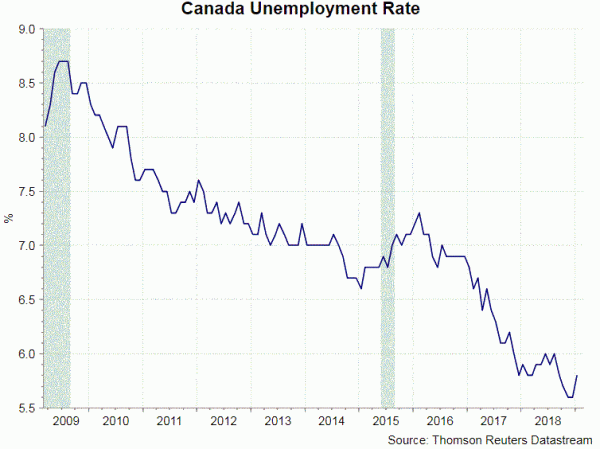BOC would leave the policy rate unchanged at 1.75% at this week’s meeting. Since the last meeting, economic data released pointed to slowdown in Canada’s growth momentum. Although Governor Stephen Poloz has recently affirmed at the central bank should still increase the policy rate to the neutral level at some point, the timing is data-dependent. It is important to monitor how the members react to the broad-based data disappointment of late.
Recent economic data suggested that a growth slowdown is in place. GDP growth eased to an annualized pace of +0.4% in 4Q18, from about +2% a quarter ago. The market had anticipated a +1% expansion. The second quarter growth rate was revised lower to +2.6%, from initial estaitme of +2.9%. All in all, growth last year was +1.8%, much weaker than 2017’s +3% and marking the lowest since 2016. Deceleration was broadly based. While household consumption contributed less to growth in the fourth quarter, government spending and business investment even contributed negative growth. These were partly offset by improvement in trade and inventories.
The manufacturing PMI, by Markit/ IHS, dropped -0.4 point to 52.6 in February, the lowest since December 2016. While employment growth was the biggest factor dragging the index, production growth was also “subdued” as “trade frictions and heightened global economic uncertainty had led to delayed decision making among clients on new orders”. The job market in January remained resilient although the unemployment rate rebounded slightly. The number of jobs increase was still remarkable, by +66.8K.
Headline CPI has been falling rather sharply after peaking in mid-2018. The January figure, at 1.4%, marked the lowest level since October 2017. Acknowledging such developments, BOC revised lowest its forecasts at the January meeting and forecast inflation to “edge further down and be below 2% through much of 2019, owing mainly to lower gasoline prices”. Yet, it added that the effects are only “transitory” and depreciation in Canadian dollar would “exert some upward pressure on inflation”, causing it to return to around the 2% “by late 2019”. Indeed, excluding volatile components such as energy prices, core CPI has remained resilient. Both of BOC’s preferred measures of CPI (CPI-trimmed and CPI- median) has stayed closed to +2%, the midpoint of the central bank’s target range.
On the monetary policy outlook, Governor Poloz noted in a speech two weeks ago that the policy rate would need to move “up into a neutral range over time, to a point where it is not stimulating or constraining economic growth”. He added, however, that “the path back to that neutral range is highly uncertain” and any move should be data dependent.

















